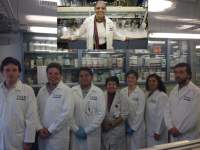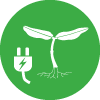- Sanitation systems
- Faecal sludge management (FSM)
- Determining helminth egg quantities (measurement techniques)
- Software to identify and quantify pathogenic helminth eggs (National University of Mexico)
Software to identify and quantify pathogenic helminth eggs (National University of Mexico)
34.3k views
- TeamWTR
-
 Topic Author
Topic Author- In the Global Development GCE Phase II, sponsored by Bill & Melinda Gates Foundation, we are the Water Treatment and Reuse Team. Our main project is to develop a software that will identify and quantify helminth eggs.
Less- Posts: 18
- Karma: 3
- Likes received: 10
Re: Software to identify and quantify pathogenic helminth eggs (University Universidad Nacional Autónoma de México (UNAM), Mexico)
The Global Development Phase II, sponsored by Bill & Melinda Gates Foundation, is focused on the elaboration of an automatic image analysis software that performs the identification and quantification of helminth eggs of a processed sample of wastewater, sludge or excreta. Alongside our investigation, we work to train people through our academic programs such as social services and undergraduate, MSc and PhD.
An example of this is the MSc thesis developed in Phase I and for which the degree examination was done at the beginning of 2014:
Pérez Sánchez, J. D. (2013). Identificación y cuantificación automática de huevos de helmintos en muestras de agua residual (in Spanish) - Automatic identification and quantification of helminth eggs in wastewater samples. MSc thesis, Universidad Nacional Autónoma de México (UNAM), Mexico.
For those of you who are interested in our software to quantify helminth eggs in wastewater samples, you might find this MSc thesis useful. It is in Spanish, but there is an English summary. You can find the full text on the link below:
susana.org/lang-en/library?view=ccbktypeitem&type=2&id=2052
Here is a section of the English summary:
Given the complexity of biological automatic image analysis, we performed a comparative study of protocols for image processing techniques applicable for this study. The development of automatic identification technique used 360 images of different species (Ascaris lumbricoides (fertile and infertile), Hymenolepis nana, H. diminuta, Schistosoma mansoni, Taenia sp., Toxocara canis and Trichuris trichiura), which allowed the training of the system and establishment of a range of values for each property classification.
System validation is always performed with residual water samples, we commonly classified it in three different qualities based on the total suspended solids (TSS). Class I was water with 150 mg / L (TSS), typical of untreated wastewater. This allowed us to validate the results according to the amount of solids present in water. For Class I and Class II, results were obtained identifying specificity 0.99 and 0.98, respectively, indicating that the system is able to distinguish between significant accuracy helminth egg and different objects. For the same quality of water, yielded a sensitivity of 0.83 and 0.80, respectively, indicating the system's ability to identify a species among other exceeds 80%. The Class III identification efficiency was considerably lower (15%) than samples I or II. So in the current conditions of the system, must be carried out a prior dilution of the samples before identification and quantification through software.
The advantages of the developed system versus the traditional technique are: a) No specific skills required for the recognition of the species. b) Samples with different amount of total suspended solids can be identified in approximately 10 minutes against three hours or more of the traditional technique. c) The initial cost of the software is 30,000 compared to 20,000 dls of the traditional technique, but the operating cost per sample is less in the case of software with 2 dlls per sample versus 10 - 35 dlls for traditional technique. Regarding the specificity and sensitivity of the developed software, both features exceed 80%, while the traditional technique depends on previously acquired human skills.
If you have questions, please don’t hesitate to ask.
Regards,
Water Treated and Reuse Team (WTR Team)
E-mails
This email address is being protected from spambots. You need JavaScript enabled to view it.
This email address is being protected from spambots. You need JavaScript enabled to view it.
This email address is being protected from spambots. You need JavaScript enabled to view it.
Instituto de Ingeniería (Engineering Institute)
Universidad Nacional Autónoma de México, Mexico City.
E-mails
Blanca Jimenez: This email address is being protected from spambots. You need JavaScript enabled to view it.
Catalina Maya: This email address is being protected from spambots. You need JavaScript enabled to view it.
Jose Antonio Barrios: This email address is being protected from spambots. You need JavaScript enabled to view it.
Please Log in to join the conversation.
You need to login to reply- TeamWTR
-
 Topic Author
Topic Author- In the Global Development GCE Phase II, sponsored by Bill & Melinda Gates Foundation, we are the Water Treatment and Reuse Team. Our main project is to develop a software that will identify and quantify helminth eggs.
Less- Posts: 18
- Karma: 3
- Likes received: 10
Re: Wanting a better way to test pathogen inactivation? Us too! Can you help me crowdsource a better way?
Blanca
Please log in or register to see it.
Instituto de Ingeniería (Engineering Institute)
Universidad Nacional Autónoma de México, Mexico City.
E-mails
Blanca Jimenez: This email address is being protected from spambots. You need JavaScript enabled to view it.
Catalina Maya: This email address is being protected from spambots. You need JavaScript enabled to view it.
Jose Antonio Barrios: This email address is being protected from spambots. You need JavaScript enabled to view it.
This message has an attachment file.
Please log in or register to see it.
Please Log in to join the conversation.
You need to login to reply- TeamWTR
-
 Topic Author
Topic Author- In the Global Development GCE Phase II, sponsored by Bill & Melinda Gates Foundation, we are the Water Treatment and Reuse Team. Our main project is to develop a software that will identify and quantify helminth eggs.
Less- Posts: 18
- Karma: 3
- Likes received: 10
Software to identify and quantify pathogenic helminth eggs (National University of Mexico)
Please find below information about our UNAM (Universidad Nacional Autónoma de México) team project to identify and quantify pathogenic helminth eggs:
Title of grant:
Software to identify and quantify pathogenic helminth eggs
Subtitle: Software to automatically identify and quantify pathogenic helminth eggs in water, wastewater, biosolids and excreta.
Name of lead organization: Universidad Nacional Autónoma de México (UNAM)
Primary contact at lead organization: Blanca Jiménez Cisneros, Ph.D.
(This email address is being protected from spambots. You need JavaScript enabled to view it.; This email address is being protected from spambots. You need JavaScript enabled to view it.)
Grantee location: UNAM, Instituto de Ingeniería, Mexico City
Developing country where the research is being or will be tested:
Mexico, Colombia, some countries of Africa (as Namibia, South Africa, Kenya), Brazil, Philippines, India, as well as developed countries such as USA, Spain and Germany.
Start and end date:
Phase I: 02/01/2012 to 06/01/2013
Phase II: 02/01/2014 to 01/01/2016
Phase III: extended until 30 Nov. 2018
• Grant type: The Grand Challenges Explorations Grant.
Phase I: USD 100,000 (www.gatesfoundation.org/How-We-Work/Quic...s/2011/10/OPP1044443)
Phase II: USD 354,284 (www.gatesfoundation.org/How-We-Work/Quic...s/2013/10/OPP1094904)
Phase III: USD 438,268 (www.gatesfoundation.org/How-We-Work/Quic...s/2016/11/OPP1149050)
Short description of the project:
The following activities have been performed:
a) Integration of a library of helminth eggs images including eight different species, at three viability stages: viable eggs, non-viable eggs, and larval eggs.
b) Software development. Its functions involve detecting and labeling all visible objects in an image, using different processes (filtration, equalization, application of algorithms, etc.), and afterwards the classification of each detected objects based on shape (area, perimeter and eccentricity), and texture properties. The image library was needed to train the software on how a specific helminth egg would look like.
c) Software first validation. Comparative tests were conducted to determine the difference between software performance, and the results given by the standard identification and quantification technique performed by expert microbiologists. Most of the validation and software improvement have been done simultaneously.
The following activities are still ongoing:
a) To include additional helminth eggs species to the recognition protocol.
b) To finish the lab validation so all the objectives can be achieved.
c) To perform international peer-labs test and validation.
d) To develop a user friendly software that may be widely distributed.
e) To find a proper distribution channel that benefits target users (mostly) in developing countries.
Goal(s) Phase I:
To provide an image processing tool to reduce the cost and time consumed by the identifying and quantifying of helminth eggs.
Objectives (Phase I):
a) Setting a workstation: the first task to begin the project was to put a microscopic image processing workstation.
b) Generating helminth eggs image library: with the workstation ready, several helminth eggs images were acquired. The species used for this objective were selected, based on their medical importance and worldwide ubiquity.
c) Developing identification software: a comparative study of the available recognition protocols and image processing techniques was performed.
d) Increasing the number of involved species of helminth eggs: additional species of helminth eggs were selected regarding the difficulty level of identification and the widespread presence.
e) System improvement: New image processing tools and changes were applied to the software. At this point a series of filters were added for image processing.
f) System validation: The validation was made using wastewater samples of three different quality levels.
Goal(s) Phase II:
To distribute this tool worldwide, and ensure mainly that those regions that have limited resources to perform wastewater, sludge, biosolids and excreta quality assessments have easy access to this tool.
Objectives (Phase II)
a) To increase the sensibility of the identification system when dealing with high solids content water (class III or raw wastewater) and establish the protocol for this case.
b) To validate the software to detect and quantify different genera of helminth eggs from samples of different water qualities including wastewater and greywater, and also from sludge, biosolids and excreta samples.
c) To include additional helminth eggs species to the recognition protocol.
d) To validate the system with international partners.
e) To test the system with Mexican partner labs which are certified in the standard technique to start local distribution.
f) To obtain a patent for the system.
g) To launch a worldwide distribution strategy.
h) To develop an easy-to-use platform of the software and the distribution strategy to reach the final users.
i) To test the last version and establish the distribution strategy.
• Research or implementation partners: Fernando Arámbula, Ph.D. CCADET, UNAM.
• Links, further readings:
Documents in SuSanA library: www.susana.org/en/resources/library/details/2048
Results to date:
a) So far, the system:
• is able to process images with a 99% of specificity, which means that it can distinguish between helminth eggs and other objects with a 99% of reliability.
• has also been validated to yield a 90% reliability to distinguish among five different helminth genera from water samples with a less than 150 mg/L of total suspended solids.
• is being tested and validated to be used for different samples (water, sludge, biosolids and excreta), so the protocol for each type of sample will be properly established, which gives the system a great versatility.
• is including additional species of helminth eggs species to the recognition protocol.
• is also aiming to take third party trials before the final version is delivered, and afterwards, to build the most suitable platform to develop a user friendly system, so we may focus on the distribution strategy.
• The patent is pending, but the methodology is already safeguarded.
• To develop an easy-to-use platform of the software and the distribution strategy to reach the final users.
• Current state of affairs: The developing team is in direct contact with international peer-labs interested on validating the software.
• Biggest successes so far: Platform ready to distinguish among eight genera of helminth eggs with 90% of reliability and 99% specificity for water samples.
• Main challenges/frustration: To broaden the software capability to analyze wastewater with higher content of total suspended solids, and develop the protocol for biosolids and excreta.
In the following paragraphs it is presented a short summary about the first results:
Software to identify and quantify pathogenic helminth eggs
The analytical technique used to identify and quantify helminth eggs, besides its time consuming nature, involves a key step in which highly trained laboratory technicians have to properly identified different types of eggs and count them. This step is the main source of errors impacting the reliability of the fulfillment of the norms or the performance of a treatment process. To overcome this problem, this project focused on the development of a software to identify and quantify different species of helminth eggs in samples.
Helminths (parasitic worms) are the origin of health risks associated with the lack of or a deficient sanitation service, the use of polluted water for irrigation, and the disposal of excreta or contaminated sludge in soils. Helminths are transmitted to humans through their eggs which are highly dangerous due to their low infectious dose, their high persistence in the environment, and their high resistance to inactivation processes. Helminthioses are endemic in Africa, Latin America and East Asia, provoking diarrhea, undernourishment, and anemia. It is estimated that around 350 million people are infected worldwide, especially children between 5 and 15 years of age.
For these reasons, since 1989, the WHO and since then many other organizations have set guidelines of standards limiting the content of helminth eggs in wastewater (1 egg/L or less), greywater, and sludge (1 egg/gTS or less) when used for agricultural irrigation. The limit values always involve the need to use a highly accurate analytical procedure. Nevertheless, it is always available, notably in developing countries, limiting the possibility to enforce the standards in the countries where it is more needed.
Given the above explained complexity to accurately analyze biological images to identify and count helminth eggs, it was decided to develop an image processing software in order to identify and count eggs from photographs taken on a microscope of a processed sample of wastewater, greywater, excreta or sludge. The developed software comprises two steps: the first is to detect and label all visible objects using different processes (filtration, equalization, application of algorithms, etc.). The second step is to classify each of the detected objects based on shape (area, perimeter and eccentricity) and texture properties (energy, mean gray level, contrast, correlation and homogeneity) as one the helminth eggs specie recognizable by the software.
Currently, the software is able to identify five species (Ascaris lumbricoides as fertile and unfertile, Trichuris trichiura, Toxocara canis and Taenia saginata) and in a next version three species more will be included (Hymenolepis nana, Hymenolepis diminuta and Schistosoma mansoni). In total, 360 images of the different species were used to set the range values for each classification property.
The software has 90% sensibility (ability to identify one specie among the others in a wastewater sample) and 0.99 specificity (potential to distinguish an egg from any other objects in a wastewater sample). Currently, the software is under adaptation to process excreta and sludge samples. Based on experimental tests the use of the software reduce the identification and quantification time response. This represents savings on the time of highly trained personnel per analysis. In addition, the reliability of the analysis increases by 90%.
More information about the pathogens inactivation is included in the next two files. The first is a paper about the synergy with different environmental conditions to inactivate helminth eggs in sludge samples, and the second one is a PDF presentation in the Disinfection World Congress (paper is in press) about the inactivation of different microorganisms.
Viability of six species of larval and non-larval helminth eggs for different conditions of temperature, pH and dryness
C. Maya, F.J. Torner-Morales, E.S. Lucario, E. Herna´ndez, B. Jime´nez*
Water Research 46 (2012), 4770 - 4782
dx.doi.org/10.1016/j.watres.2012.06.014
A b s t r a c t
Helminth eggs are the most difficult biological parasites to inactivate in wastewater and
sludge. In developing countries, in particular, they are present in high concentrations and
are the cause of many diseases that impact seriously on the human population. The
process conditions for affordable inactivation are very variable, leading to different inactivation
efficiencies. Temperature, dryness, pH and the developmental stage of the eggs
must be taken into consideration to achieve complete inactivation. The objective of this
research was to study the inactivation of six species of larval and non-larval helminth eggs
of medical importance in developing countries under controlled conditions of temperature,
pH, dryness and contact time. Results showed considerable differences in inactivation
conditions among helminth eggs and a high level of resistance was confirmed for the eggs
of Ascaris lumbricoides and Ascaris suum. The appropriate conditions for inactivation of all
types of eggs were found by applying combinations of pH, temperature and dryness. At
45 C it was possible to inactivate all species with a pH of 5.3 and 90% dryness within 6
days. If alkalization was applied, a pH of 12.7 was sufficient over 19 days at the same
conditions of dryness and temperature. From these results it is proposed that both Ascaris
spp. and Taenia solium may be used as indicators of biological contamination in wastewater
and sludge.
Please log in or register to see it.
Please log in or register to see it.
Blanca
Instituto de Ingeniería (Engineering Institute)
Universidad Nacional Autónoma de México, Mexico City.
E-mails
Blanca Jimenez: This email address is being protected from spambots. You need JavaScript enabled to view it.
Catalina Maya: This email address is being protected from spambots. You need JavaScript enabled to view it.
Jose Antonio Barrios: This email address is being protected from spambots. You need JavaScript enabled to view it.
This message has attachments files.
Please log in or register to see it.
Please Log in to join the conversation.
You need to login to reply- Sanitation systems
- Faecal sludge management (FSM)
- Determining helminth egg quantities (measurement techniques)
- Software to identify and quantify pathogenic helminth eggs (National University of Mexico)







